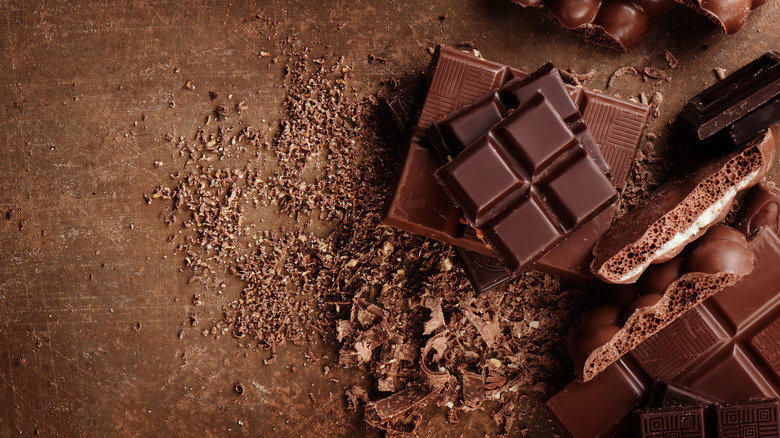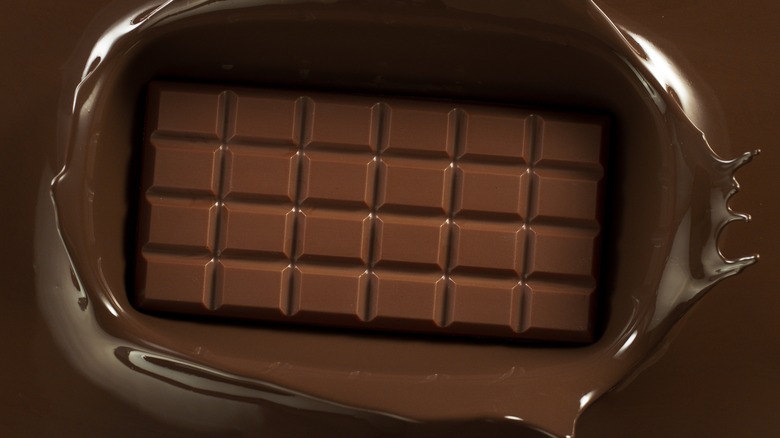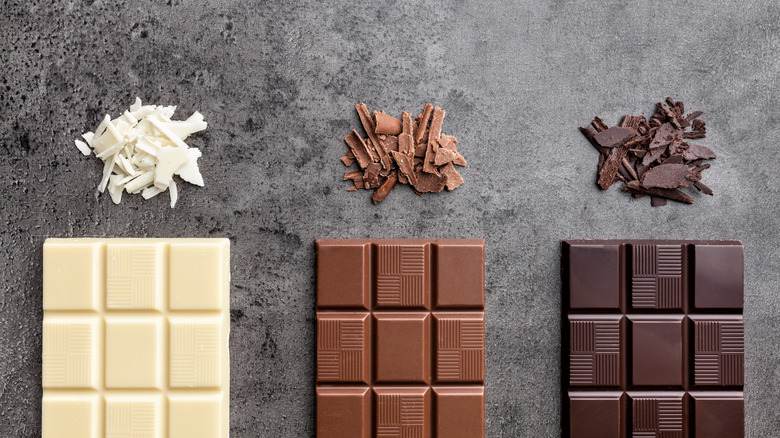Why You Shouldn't Overlook Milk Chocolate
As children, many of us loved milk chocolate. That smooth, rich sensation of the chocolate melting on your tongue was equal parts comforting and joyful. But as we grew up, many of us graduated from our childhood chocolate tastes and began to switch it up. Dark chocolate became the chocolate of choice for many, with its rich flavor and bitter edge. If you're someone who left your milk chocolate days behind in favor of dark chocolate, you may want to reconsider as there's a type of chocolate that may just become your new favorite.
Chocolate is defined and classified by the amount of cocoa liquor it contains. Cacao (not cocoa) is the raw form of chocolate that is processed to make cocoa butter and cocoa liquor, according to WebMD. Cocoa liquor (which is not alcoholic), is combined with cocoa butter and sugar to make chocolate as we know it. Some bars, including, logically enough, milk chocolate, also include milk.
Chocolate with 100% cacao is baking chocolate, and it is very bitter. Dark chocolate bars and candy range from 50% to 90% cacao, according to the Harvard School of Public Health, while milk chocolate may be as low as 10%. Milk chocolate has less cocoa which is why it is lighter in color and sweeter in flavor. Given these facts, why should someone with a sophisticated palette take another look at milk chocolate?
Dark milk chocolate
Chocolate is big business. Adults in the United States spend $21 billion per year on chocolate, according to Axios, and milk chocolate is the most popular, with 49% of Americans choosing that variety, according to YouGov. But there's something else on the market that may change the minds of milk chocolate and dark chocolate lovers.
According to The New York Times, chocolatiers started marketing a new kind of milk chocolate called dark milk chocolate, with some offerings incorporating a variety of undertones like smoke, fruit, and molasses. According to Food & Wine, dark milk chocolate contains around 50% cacao, but added ingredients help the chocolate taste smoother and creamier.
Specialty chocolatier Denise Castronovo, the founder of Florida's Castronovo Chocolate, told Food & Wine she is experimenting with cocoa nibs from countries like Venezuela and Columbia, adding a bit more sugar and milk solids, and creating truly delicious chocolate that combines the best of milk and dark. She also explained that dark milk chocolate can be sophisticated, stating, "Our dark milk chocolate has been used to pair with whiskey; some we pair with wines to show that this is [a] fine food, not a candy."
Have a chocolate tasting
Now that you know about dark milk chocolate, indulge a bit and have a tasting. Buy your favorite milk and dark chocolate bars (maybe even include some white chocolate), then add dark milk chocolate to the mix.
America's Test Kitchen ranked some interesting milk chocolate bars, from Scharffen Berger Extra Rich Milk Chocolate with 41% cacao to Endangered Species Chocolate Smooth + Creamy Milk Chocolate, with 48% cacao. The Ultimate Chocolate Blog lists Castronovo Dark Milk Chocolate, with 63% cacao, as a top choice, and says that Fruition Dark Milk with Flor de Sal, which has 56% cacao, is another great bar. Lindt makes a Classic Recipe Dark Milk High Cocoa Chocolate Bar.
And you can use dark milk chocolate in baking. Melt it and put it in brownies, like this recipe for bourbon pecan brownies, or chocolate cake, like this flourless chocolate cake with walnuts. You can even chop the chocolate and fold it into chocolate chip cookies. And, of course, you can always keep a few dark milk chocolate bars on your bedside table for those inevitable late-night munchies.


